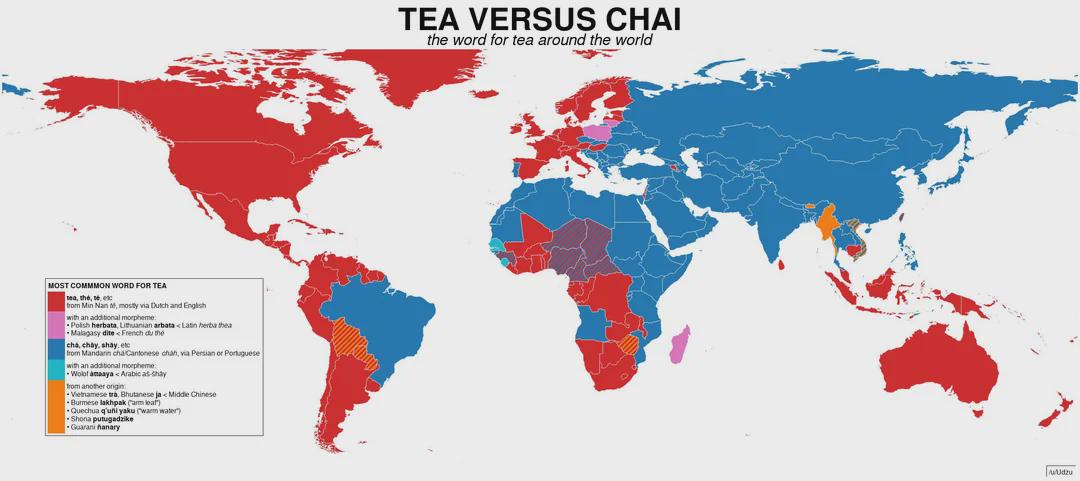How Countries Say 'Tea' Map


Marcus Rodriguez
Historical Geography Expert
Marcus Rodriguez specializes in historical cartography and geographic data analysis. With a background in both history and geography, he brings unique...
Geographic Analysis
What This Map Shows
This visualization presents a fascinating linguistic exploration of how different countries around the world refer to the beloved beverage: tea. The map highlights the various terms used across nations, showcasing the rich tapestry of cultural interpretations and adaptations of this age-old drink. From 'chai' in India to 'te' in Spain, the names not only reveal linguistic diversity but also hint at historical and cultural connections surrounding tea consumption.
Deep Dive into Tea Terminology
Tea, a beverage enjoyed by millions, has a history that dates back thousands of years, with its origins rooted in ancient China. The word 'tea' itself comes from the Amoy Chinese word 'tê,' which spread globally as trade routes expanded. Interestingly, the different names for tea across the globe reflect not just linguistic variations but also the cultural significance and preparation methods associated with this drink.
In many Asian countries, tea is more than just a drink; it’s an integral part of social rituals and traditions. In India and Pakistan, for example, 'chai' refers to a spiced milk tea that is often enjoyed with snacks and is a staple in households. The preparation of chai involves boiling tea leaves with milk, sugar, and various spices like cardamom or ginger, creating an aromatic experience that is central to social gatherings.
In contrast, in Japan, 'ocha' denotes not just green tea but also the cultural practices surrounding its preparation and consumption, including the famous tea ceremony, which emphasizes aesthetics, harmony, and mindfulness. The meticulous process of whisking matcha, a powdered green tea, into a frothy brew exemplifies the deep respect the Japanese have for tea as an art form as much as a beverage.
Europe has its own unique interpretations, with the word 'tea' predominant in English-speaking countries, while 'te' is common in Spanish-speaking nations. However, in countries like Russia, tea is known as 'chai' as well, showcasing the influence of trade routes and cultural exchanges throughout history. Russian tea culture often features a samovar, a traditional kettle used to brew tea and serve it alongside raspberry jam or lemon, illustrating the communal aspect of tea drinking in Russian society.
Interestingly, in some regions, the name for tea varies even within the same language due to regional dialects or local adaptations. For instance, in the United Kingdom, while 'tea' is commonly used, there are regional variations like 'cuppa' or ‘brew’ that reflect local colloquialisms and the importance of tea in British culture.
Regional Analysis
Examining the map reveals distinct regional patterns in the terminology for tea. In Asia, where tea originated, you'll find the greatest variety of names and cultural practices surrounding this beverage. The Middle East, where tea has been integral to hospitality, also uses 'chai' widely, reflecting historical trade links with India.
In Africa, several countries have their own terms for tea, often influenced by colonial history. For instance, in Ethiopia, tea is called 'shai,' which is a direct adaptation of the Arabic 'chai.' This reveals how trade and cultural exchanges have shaped the way tea is perceived and named in different regions.
In Europe, you’ll observe a mix of 'tea' and 'te,' often influenced by historical connections to trade and colonization. Countries like the Netherlands and Germany also have their own variations, showcasing the impact of both linguistic roots and cultural exchanges over centuries.
Interestingly, the Americas reflect a blend of these influences, with terms like 'té' in Spanish-speaking countries and 'tea' in English-speaking countries. The diversity of tea terminology in the Americas highlights the rich cultural tapestry formed by the convergence of indigenous and colonial histories.
Significance and Impact
Understanding how different cultures refer to tea is significant beyond mere linguistics. It provides insight into social customs, historical trade routes, and cultural values. Tea is not just a beverage; it is a symbol of hospitality, social connection, and cultural identity.
Current trends show a growing global interest in various tea types, from herbal to green tea, as well as an appreciation for traditional tea ceremonies, such as the Japanese tea ceremony or the British afternoon tea. As global connectivity increases, the dialogue around tea continues to evolve, influencing how it is consumed and celebrated across different cultures.
Moreover, the tea industry itself is witnessing significant changes, with a rising demand for specialty teas and sustainable farming practices. As consumers become more aware of the origins of their tea, the cultural significance and the stories behind these names take on new importance.
In conclusion, the map of how countries say 'tea' is much more than just a linguistic exploration. It encapsulates a global culture steeped in history, tradition, and social connection, revealing the nuances of how a simple beverage can unite or differentiate societies around the world.
Visualization Details
- Published
- September 10, 2025
- Views
- 76
Comments
Loading comments...